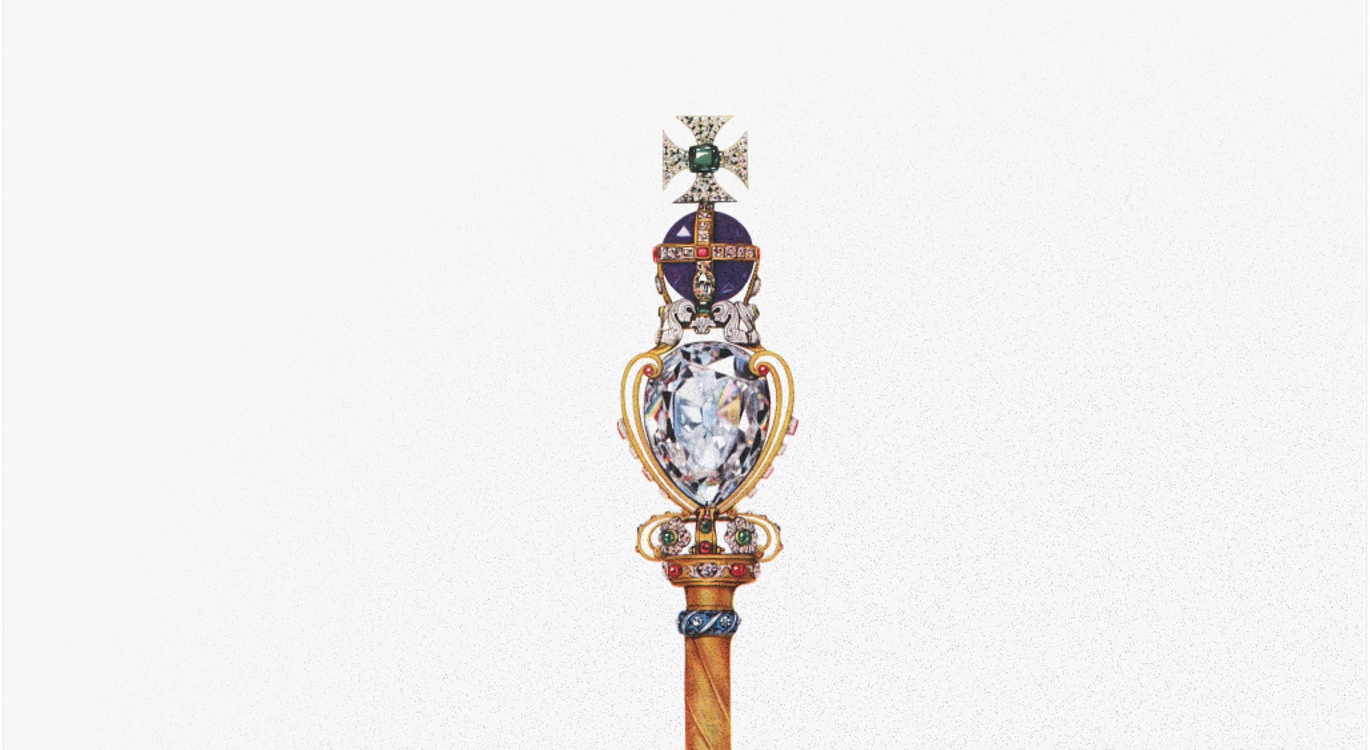Upon the coffin, and securely fastened to it, lay six items each with symbolic significance. In 1936, the Golden Orb and the cross on the top of the Imperial Crown broke off and fell into a gutter as the coffin of King George V was being moved from London's King's Cross station; hence the precaution of fastening them:
- A handwritten note from King Charles II;
- Flowers and foliage from the royal properties of Buckingham Palace, Clarence House and Highgrove House;
- The Imperial State Crown;
- The Golden Orb;
- The Royal Standard;
- The Sovereign Sceptre.
Forming part of the Crown Jewels, the Sovereign Sceptre is a beautiful and rarely used part of the Coronation Regalia. During King Charles’ coronation on 6th May, this will be one of two Sceptres held by the King.
The Sovereign's Sceptre with Cross, the one seen during Queen Elizabeth's funeral service, is meant to represent the crown’s temporal authority, and has been used in the coronation of every British monarch since 1661, when it was created for the coronation of King Charles II.
This sceptre was altered for the coronation of King George IV in 1820, an enamelled rose, thistle, and shamrock being added. In 1910, King George V had it altered again to include the largest cut white diamond in the world, called the Cullinan. The Sceptre had to be reinforced to hold the weight of the diamond, which is contained in a hinged structure so that the stone can be removed and worn separately.
The Sovereign's Sceptre with Dove will also feature in the coronation. Instead of the Cullinan diamond, it has an enamelled dove on a golden cross at its peak. This is a symbol of the monarch's spiritual role and was also created for the 1661 coronation of Charles II.
The sceptre in the hand of a sovereign is an ancient symbol and can be seen in artefacts from as early as Ancient Egypt and Mesopotamia, as well as featuring in the early books of the Bible:
“The sceptre shall not depart from Judah, nor a lawgiver from between his feet, until Shiloh comes; and to Him shall be the obedience of the people” (Genesis 49:10).
"So it was, when the king saw Queen Esther standing in the court, that she found favour in his sight, and the king held out to Esther the golden sceptre that was in his hand. Then Esther went near and touched the top of the sceptre” (Esther 5:2).
It was in mockery of this symbol of sovereign authority that Roman soldiers placed a reed into the right hand of the Lord Jesus prior to his crucifixion:
“When they had twisted a crown of thorns, they put it on His head, and a reed in His right hand. And they bowed the knee before Him and mocked Him, saying, ‘Hail, King of the Jews!’” (Matthew 27:29).
Little did they know that the man standing before them was the Son of God, whose power and authority eclipsed that of the Caesar they served, and of every other ruler and kingdom. He was the Sovereign of the Universe who had, for a short time, humbled Himself, as the Apostle Paul explains:
“but made Himself of no reputation, taking the form of a bondservant, and coming in the likeness of men. And being found in appearance as a man, He humbled Himself and became obedient to the point of death, even the death of the cross. Therefore God also has highly exalted Him and given Him the name which is above every name, that at the name of Jesus every knee should bow, of those in heaven, and of those on earth, and of those under the earth, and that every tongue should confess that Jesus Christ is Lord, to the glory of God the Father” (Philippians 2:7-11).
Instead of a reed, or even the dazzling Cullinan diamond, the Lord Jesus, as the ultimate Sovereign, bears the sceptre of righteousness. As surely as He died on the cross, the Lord Jesus has been exalted in heaven and will receive the homage of all humanity: “Thy kingdom come. Thy will be done in earth, as it is in heaven” (Matthew 6:10 KJV).
The coming kingdom of the Lord Jesus will be like no other kingdom that has existed. History is punctuated by the rise and fall of kingdoms and empires which were built upon the foundation of unrighteousness, the symbolic sceptres in the hands of their sovereigns reflecting the source of their power. The kingdom and rule of the Lord Jesus is righteous. He is righteous, unlike all the other flawed and sinful sovereigns of history. His judgements are marked by equity and wisdom.
“But to the Son He says:
‘Your throne, O God, is forever and ever;
A sceptre of righteousness is the sceptre of Your kingdom.’” (Hebrews 1:8).
“. . . and he shall not judge after the sight of his eyes, neither decide after the hearing of his ears; but with righteousness shall he judge the poor, and decide with equity for the meek of the earth . . . and righteousness shall be the girdle of his waist, and faithfulness the girdle of his loins” (Isaiah 11:3-5 ASV).
King Charles will bear two sceptres during his coronation. One will represent his authority over people in the secular realm, and the other will signify His spiritual authority –primarily as the head of the Church of England.
Although there is obvious historical significance to these items, the symbols do not represent the reality today. In our Parliamentary democracy the head of state is a ceremonial figure with no real power to govern the realm. Equally, the role of the head of state in the spiritual life of the nation is from a different age.
In contrast to King Charles, the Lord Jesus is actively sovereign in His spiritual kingdom, which includes all who receive Him as Lord and Saviour. In this present age it is not represented by military might or diplomatic missions, as the Lord Himself said:
“My kingdom is not of this world. If My kingdom were of this world, My servants would fight, so that I should not be delivered to the Jews; but now My kingdom is not from here” (John 18:36).
There is coming a day when the Lord Jesus will return to earth and His kingdom will be spiritual and material. As the prophets wrote long ago:
“Yet I have set My King
On My holy hill of Zion.”
“I will declare the decree:
The Lord has said to Me,
‘You are My Son,
Today I have begotten You.
Ask of Me, and I will give You
The nations for Your inheritance,
And the ends of the earth for Your possession.
You shall break them with a rod of iron;
You shall dash them to pieces like a potter’s vessel.’ ” (Psalm 2:6-9).
“In His days the righteous shall flourish,
And abundance of peace,
Until the moon is no more.
He shall have dominion also from sea to sea,
And from the River to the ends of the earth.
Those who dwell in the wilderness will bow before Him,
And His enemies will lick the dust.
The kings of Tarshish and of the isles
Will bring presents;
The kings of Sheba and Seba
Will offer gifts.
Yes, all kings shall fall down before Him;
All nations shall serve Him” (Psalm 72:7-11).
Before that day dawns we have a decision to make – do we hand the Lord Jesus a reed or a sceptre? None of us literally hand him either, but figuratively we do by the degree to which we allow Him to control our lives. So what will it be? Will we hand Him the keys to our little kingdom and yield to His rule or will we stand with the soldiers and mock His claims by putting a reed in His hand?



